Have you ever thought about combining the sweet, buttery richness of pound cake with the briny tang of pickles? It might sound unconventional, but pickle pound cake is a delightful surprise for anyone who enjoys exploring new flavor combinations. This dessert brings the perfect harmony of savory and sweet, with finely chopped pickles adding bursts of tanginess in every bite. Topped with a simple pickle glaze, it’s an unforgettable treat for adventurous bakers—or those simply looking to use up some leftover pickles!
If you’re skeptical, trust me—this cake has a way of winning hearts. The moment you cut into its soft crumb, those little flecks of pickle peeking through, you’ll know you’re in for something special.
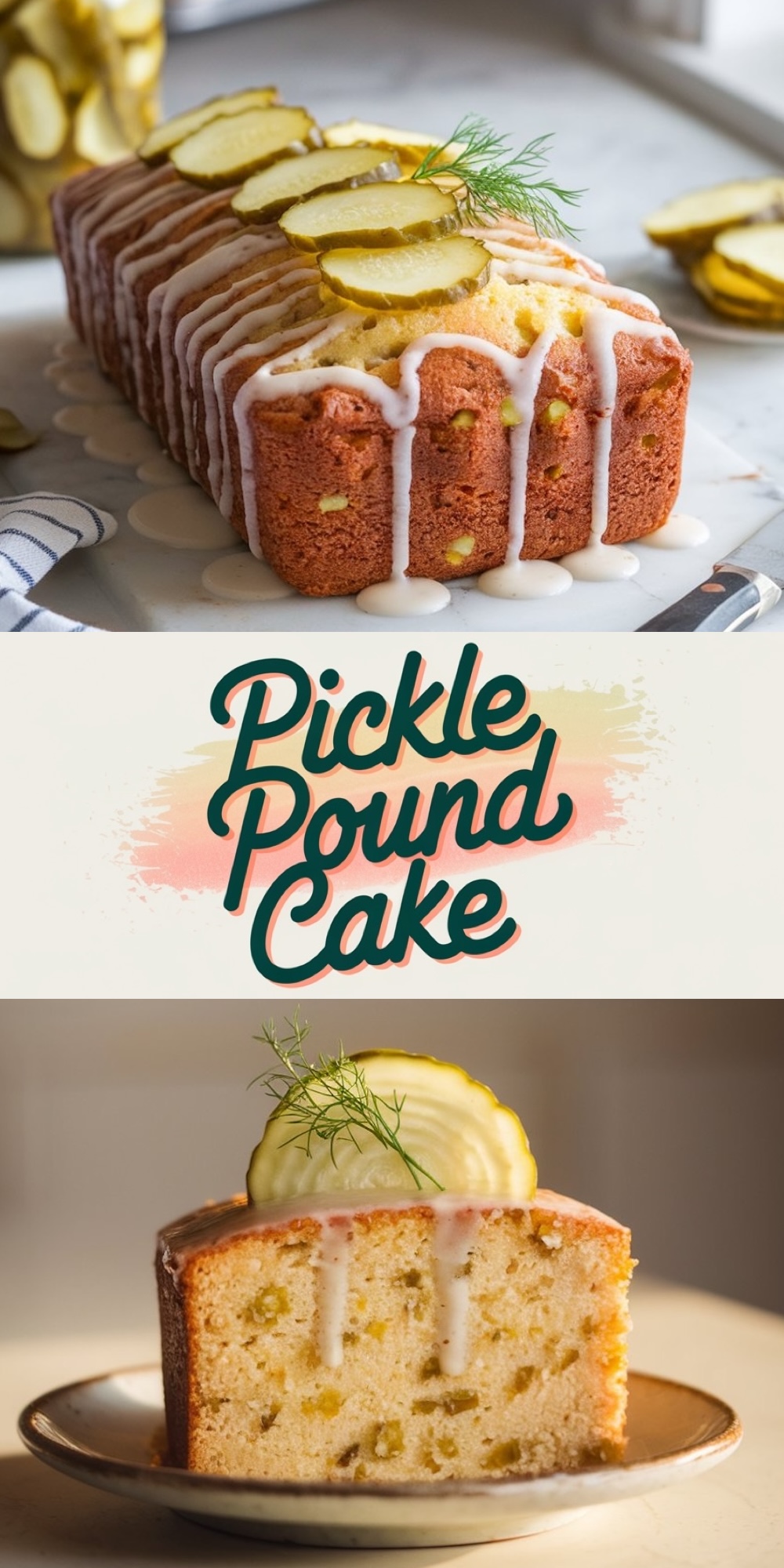
What You’ll Need for Pickle Pound Cake
The ingredients for this cake are pantry staples with a fun twist. Here’s what you’ll need:
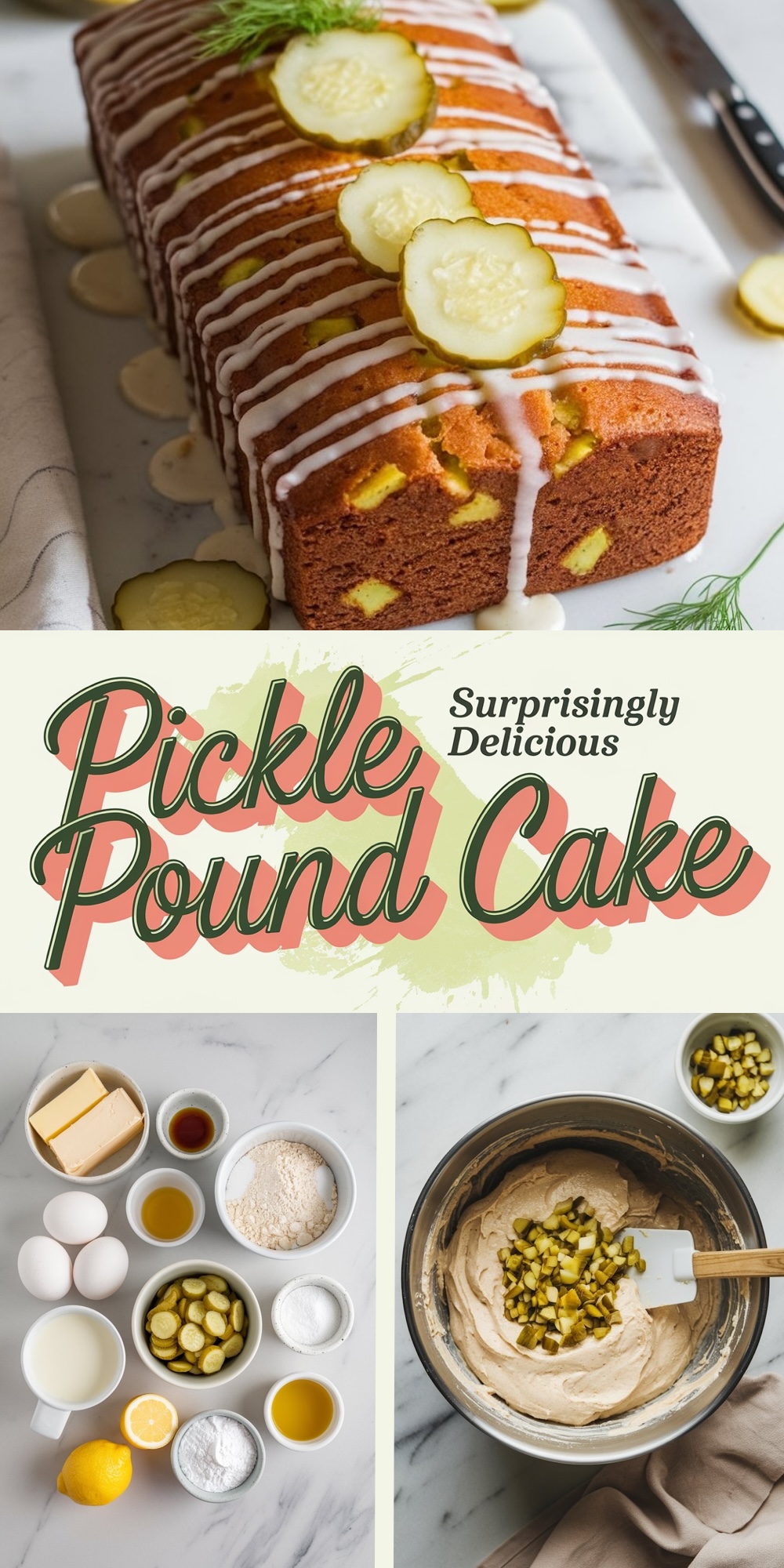
- Basic Baking Essentials: All-purpose flour, baking powder, and salt form the foundation of the cake. These ensure the pound cake has the perfect rise and texture.
- Rich, Buttery Base: Butter and sugar come together to create that classic, moist pound cake crumb. Don’t skimp on the butter—it’s key to the luxurious texture!
- Moisture and Flavor: Eggs, vanilla extract, and buttermilk balance out the batter, adding flavor and tenderness. Buttermilk is especially crucial for creating a soft, fluffy texture while complementing the tangy notes of the pickles.
- The Star Ingredient: Pickles! Finely chopped pickles (dill or bread-and-butter, depending on your taste) are folded into the batter to create bursts of flavor. Choose pickles with a subtle crunch for the best texture.
- The Glaze: Powdered sugar and pickle juice form the base of the glaze. A splash of lemon juice can be added for extra tang. The glaze ties the cake together, providing sweetness to balance the savory elements.
The Baking Process Explained
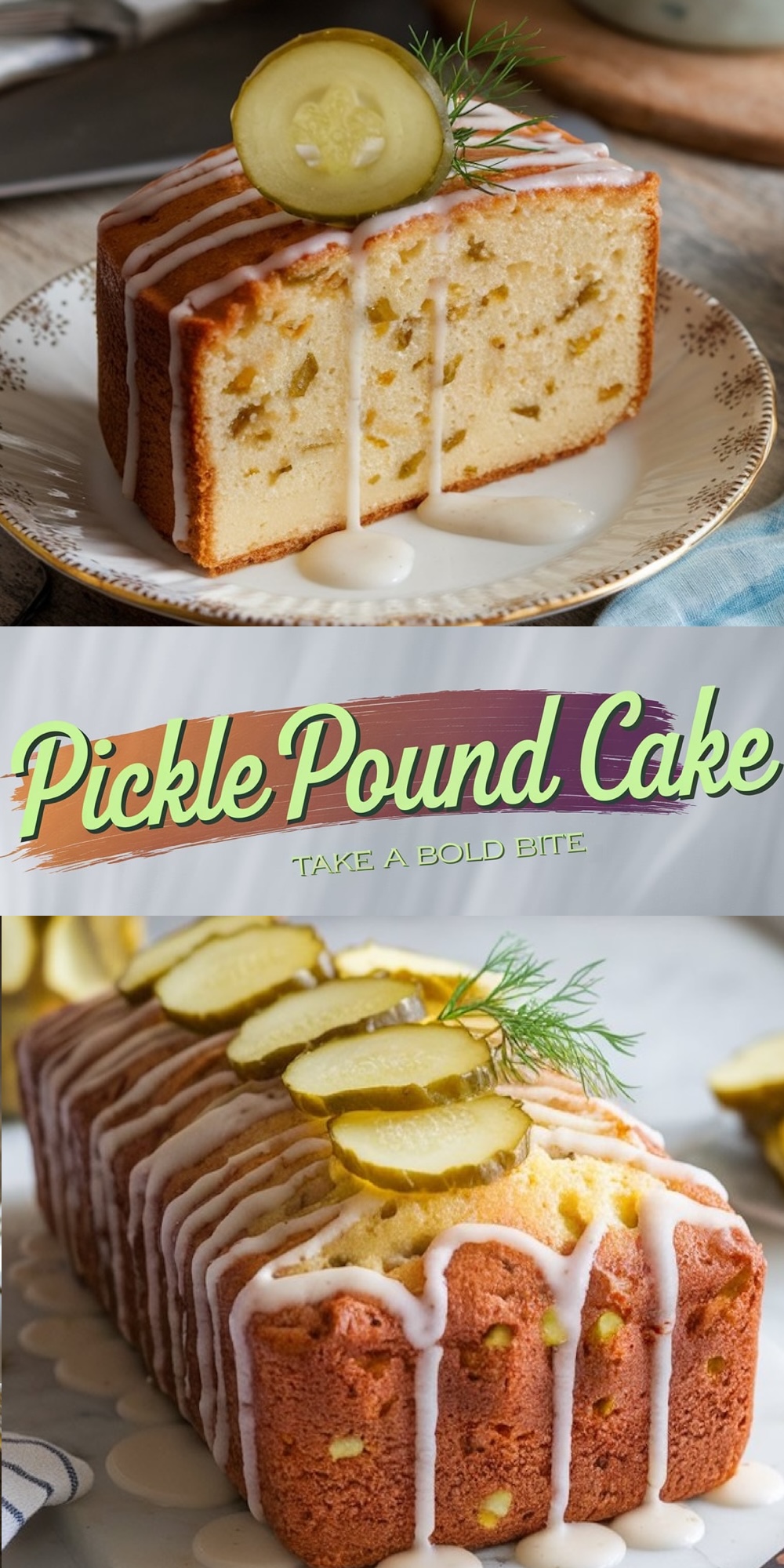
Making this pickle pound cake is as fun as eating it! Here’s how it all comes together:
Preparing the Batter
Start by creaming softened butter and granulated sugar until the mixture is light and fluffy. This step is crucial for creating an airy texture in the final cake. Gradually add the eggs one at a time, followed by a splash of vanilla extract for a hint of warmth.
Next, combine the dry ingredients—flour, baking powder, and salt—in a separate bowl. Slowly add this mixture to the wet ingredients in alternating batches with buttermilk. This method ensures the batter remains smooth and lump-free. Finally, gently fold in the chopped pickles. The batter will be rich and creamy with little flecks of pickles scattered throughout.
Baking the Cake
Pour the batter into a greased and parchment-lined loaf pan, smoothing the top with a spatula. Baking at 350°F (175°C) ensures the cake bakes evenly, developing a golden-brown crust. Keep an eye on the cake toward the end of the baking time—when a toothpick inserted into the center comes out clean, it’s ready! Let the cake cool in the pan for 10 minutes before transferring it to a wire rack.
Adding the Glaze
While the cake cools, whisk together powdered sugar and pickle juice to create the glaze. It should be smooth and pourable but not too runny. For an extra tangy kick, add a squeeze of lemon juice. Once the cake is fully cooled, drizzle the glaze over the top, letting it cascade down the sides for a stunning finish.
Why Pickles Work in a Dessert
The idea of pickles in a cake might feel counterintuitive, but it’s a testament to the magic of balancing flavors. The saltiness and tanginess of the pickles cut through the sweetness of the pound cake, creating a harmonious contrast. Think of it like adding sea salt to chocolate—it enhances the overall flavor. Pickles also add a bit of texture, keeping each bite interesting.
Plus, pickles are full of bold, zippy flavors that wake up your taste buds. Combined with the buttery richness of the cake, they create an exciting new dessert experience.
Presentation Tips for a Stunning Cake
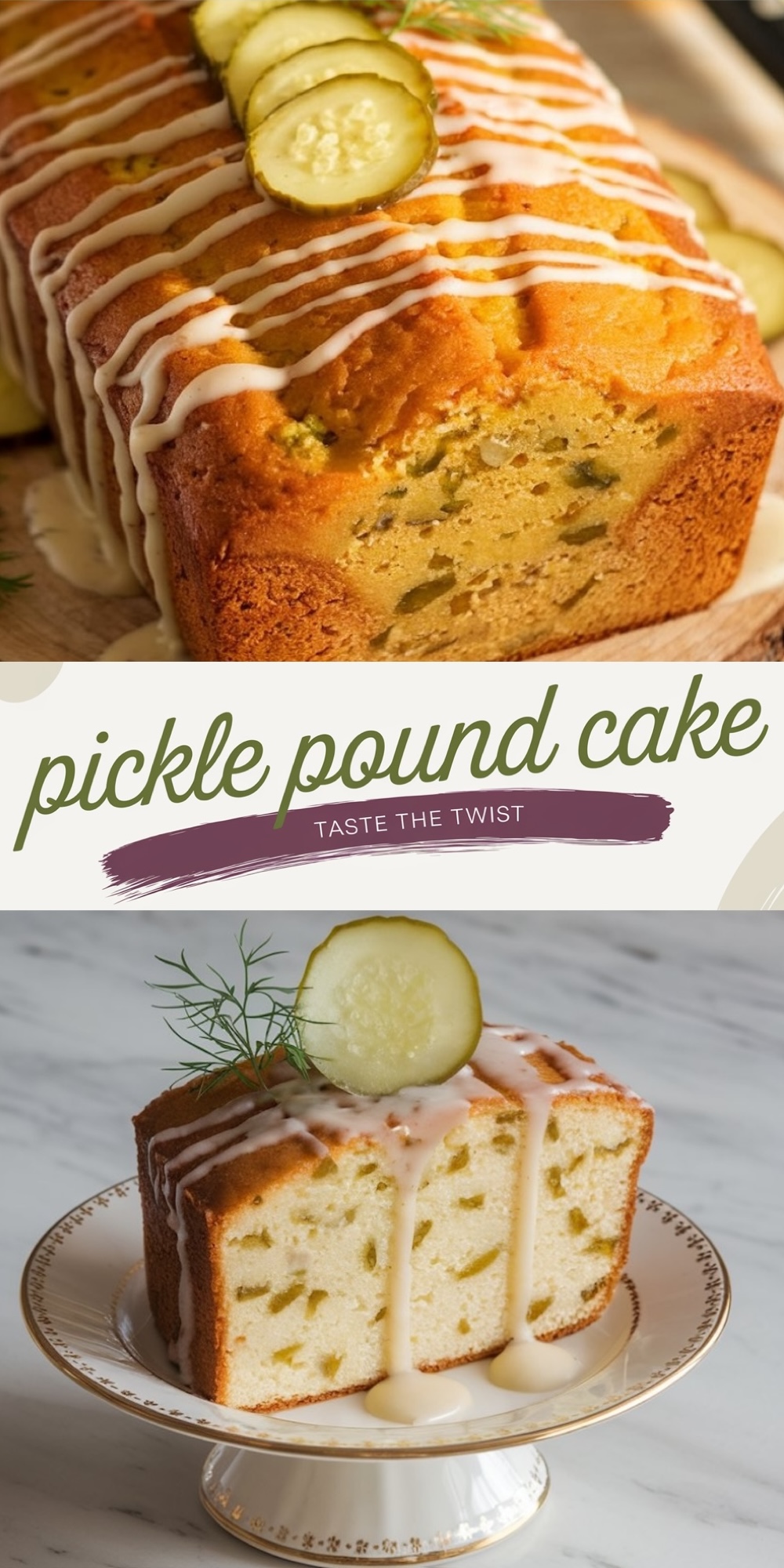
The pickle pound cake is already unique, but here are some ways to make it visually stunning for serving:
- Garnish with Pickles: Thinly sliced pickles arranged on top of the glazed cake add a quirky yet elegant touch. Use sprigs of fresh dill for a pop of green.
- Drip Glaze Artfully: Let the glaze drip down the sides of the loaf naturally—it creates a rustic yet beautiful presentation.
- Use a Pretty Cake Stand: Display the cake on a vintage or minimalist cake stand to elevate its aesthetic appeal.
Serving Suggestions
This pickle pound cake is versatile and pairs beautifully with a variety of accompaniments:
- With Coffee or Tea: The sweet and tangy flavors make it a great match for a warm cup of black coffee or herbal tea.
- With a Cheese Platter: Serve it as a unique addition to a cheese board—it complements creamy cheeses and salty crackers.
- For Parties: Slice it thinly and serve as part of a dessert spread for a fun conversation-starter at gatherings.
Why You Should Try It
This pickle pound cake is more than just a novelty—it’s a genuinely delicious dessert that challenges your taste buds in the best way possible. It’s buttery, tender, and balanced with a hint of briny tanginess. Whether you’re looking for a recipe to surprise your family, wow your friends, or simply satisfy your curiosity, this cake is an absolute must-try.
So, step out of your comfort zone and bake something extraordinary. You might just find your new favorite dessert!
More Pound Cake Recipes to Try
If you love baking pound cakes, here are a few more delicious options to add to your list:
• Butter Pecan Pound Cake Recipe: A rich, buttery pound cake with toasted pecans and a sweet caramel glaze.
• Cream Cheese Pound Cake: Smooth, moist, and tender with a rich flavor from cream cheese.
• 7-Up Pound Cake: A classic pound cake with a light lemon-lime flavor and a simple zesty glaze.
Each one brings something special to the table and is sure to impress. Give them a try and enjoy every slice.
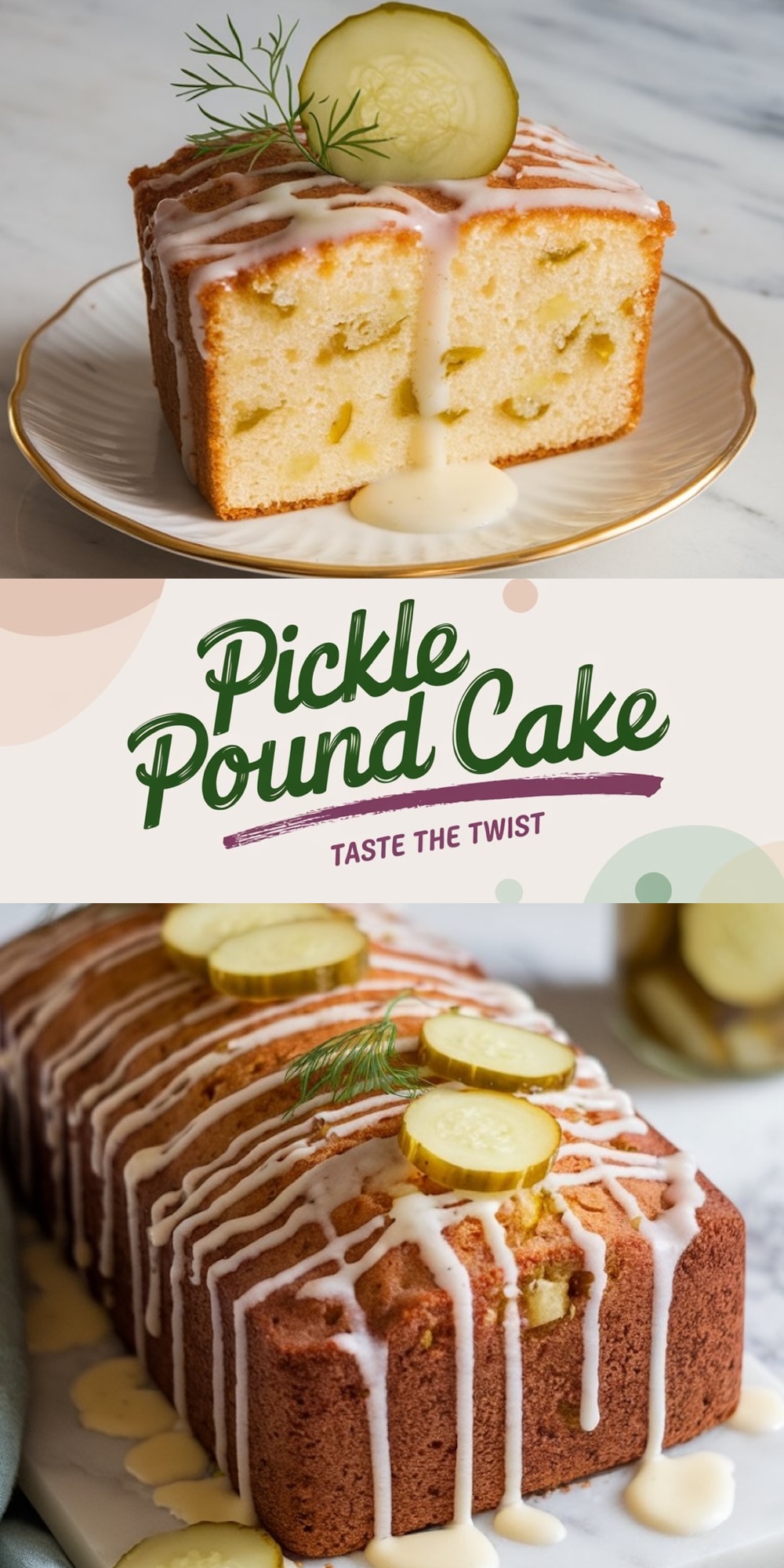
Happy baking!
Have I convinced you to give this pickle pound cake a shot? I hope so because it’s a recipe that never fails to surprise and delight. If you try it, I’d love to hear how it turned out! Leave a comment below, share your thoughts, or tag me on social media—I can’t wait to see your pickle-inspired creations.
Love this recipe? Pin it to your dessert inspiration board so you can try it anytime.
Pickle Pound Cake
Course: Pound Cakes10
servings20
minutes55
minutes300
kcalIngredients
- For the Cake:
2 ½ cups (315g) all-purpose flour
2 tsp baking powder
½ tsp salt
1 cup (230g) unsalted butter, softened
1 ¾ cups (350g) granulated sugar
4 large eggs, room temperature
1 tsp vanilla extract
½ cup (120ml) buttermilk
1 cup finely chopped pickles (dill pickles or bread-and-butter pickles work best)
- For the Glaze:
1 cup (120g) powdered sugar
2 tbsp pickle juice (adjust for consistency)
1 tsp lemon juice (optional, for extra tang)
- Garnish (optional):
Thin pickle slices
Fresh dill sprigs
Steps
- 1. Prepare the Batter
- Preheat your oven to 350°F (175°C). Grease and line a 9×5-inch loaf pan with parchment paper.
- In a medium bowl, whisk together the flour, baking powder, and salt. Set aside.
- In a large bowl, cream the butter and sugar together until light and fluffy, about 2–3 minutes.
- Beat in the eggs one at a time, ensuring each one is fully incorporated before adding the next. Stir in the vanilla extract.
- 2. Combine the Wet and Dry Ingredients
- Gradually add the dry ingredients to the butter mixture in three additions, alternating with the buttermilk. Start and end with the dry ingredients. Mix just until combined; don’t overmix!
- Gently fold in the chopped pickles until evenly distributed.
- 3. Bake the Cake
- Pour the batter into the prepared loaf pan and smooth the top with a spatula.
- Bake for 55–65 minutes, or until a toothpick inserted into the center comes out clean.
- Let the cake cool in the pan for 10 minutes, then transfer it to a wire rack to cool completely.
- 4. Make the Glaze
- In a small bowl, whisk together the powdered sugar and pickle juice until smooth. If you prefer a tangier glaze, add the lemon juice. Adjust the thickness by adding more powdered sugar or pickle juice as needed.
- 5. Glaze and Garnish
- Drizzle the glaze over the cooled cake, letting it drip down the sides.
- For a fun finishing touch, garnish with thin pickle slices and fresh dill sprigs.


